Physical Address
304 North Cardinal St.
Dorchester Center, MA 02124
The authors thank Dr. Sara Monaco, who was a co-author of this chapter in the previous edition.
Immunocytology, or immunocytochemistry (ICC), involves the use of ICC in diagnostic cytopathology. The application of immunostains in cytology cases has expanded and improved our ability to make definitive and accurate diagnoses beyond prior special stains. As seen in surgical pathology, a great deal of progress and expansion has occurred over the years in immunocytology, which has led to an increased number of available antibodies and subsequently an increased use of antibodies in cytopathology.
The many roles of immunostains in cytopathology are summarized in Box 21.1 . These include the ability to determine the cell type, such as differentiating lymphoid and epithelial cells by using CD45 (leukocyte common antigen [LCA]) and cytokeratin, respectively. In addition, immunostains help provide site-specific markers to determine the tissue of origin in a metastatic carcinoma and help to subclassify poorly differentiated malignancies. Immunostains for infectious etiologies also exist and can help determine the type of bacterial, fungal, viral, or other infection. Immunostains such as Ki-67 also help to grade certain malignancies, particularly neuroendocrine and mesenchymal tumors. , New antibodies are also being used to screen cases for potential molecular abnormalities, and in some cases confirm malignancy such as mesothelioma, as a quicker and cheaper alternative to upfront molecular testing. This increasing role and interest in using immunostains to provide predictive and prognostic information for patients continues to grow, and these roles will be addressed in greater detail in this chapter.
Determine cell type (e.g., lymphocyte vs. epithelial cell).
Determine tissue of origin by using site-specific markers, such as use of thyroid transcription factor 1 in metastatic carcinoma to support a pulmonary or thyroid origin.
Subclassify the type of infection by using immunostains for viruses, such as herpes simplex virus and cytomegalovirus, and so on.
Confirm malignancy, e.g., loss of BAP1 or MTAP in malignant mesothelioma.
Subclassify or subtype tumors (e.g., subclassify non-small cell carcinoma as adenocarcinoma or squamous cell carcinoma).
Grade malignancies, such as with Ki-67 in neuroendocrine and mesenchymal neoplasms.
Provide prognostic and predictive information (e.g., ERBB2 in breast carcinoma).
Both fine needle aspirates (FNA) and exfoliative specimens can be used for ICC by using a variety of cell preparations that include cytospins, smears or imprints, liquid-based cytology (LBC) specimens (e.g., ThinPrep [Hologic, Bedford, MA] specimens and SurePath (Becton Dickinson Diagnostic Systems, Sparks, MD), and cell blocks (CBs; Figs. 21.1 and 21.2 ). The initial cytomorphologic evaluation helps to determine the need for ICC and other ancillary studies to reach a definitive diagnosis and exclude other entities in the differential diagnosis. Once the initial Romanowsky or Papanicolaou stains have been examined, a differential diagnosis is generated, and the specimen is appropriately triaged; this procedure includes selection of the optimal cell preparation for immunostains and other ancillary studies, which can help answer important questions and support the diagnosis.
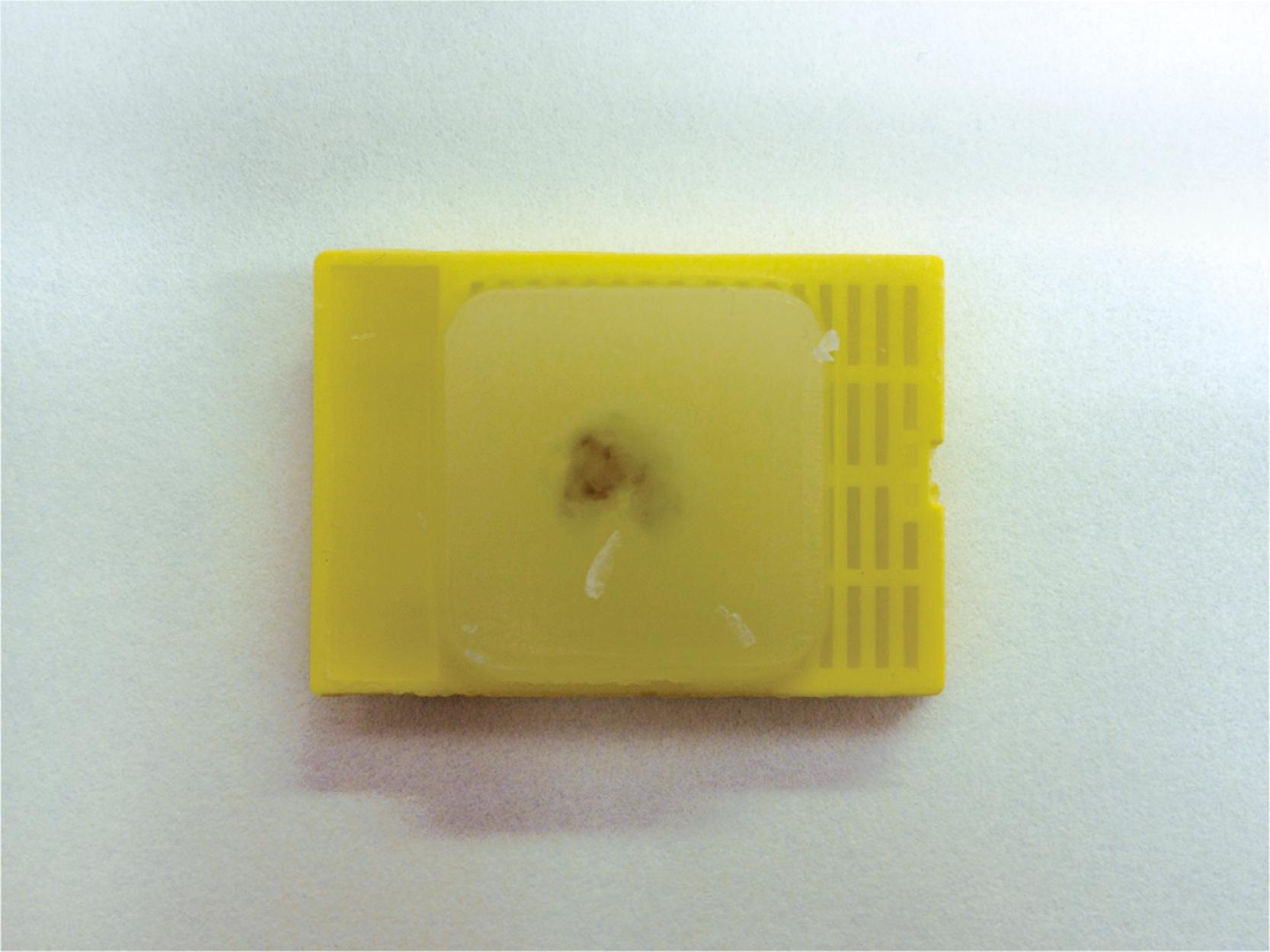
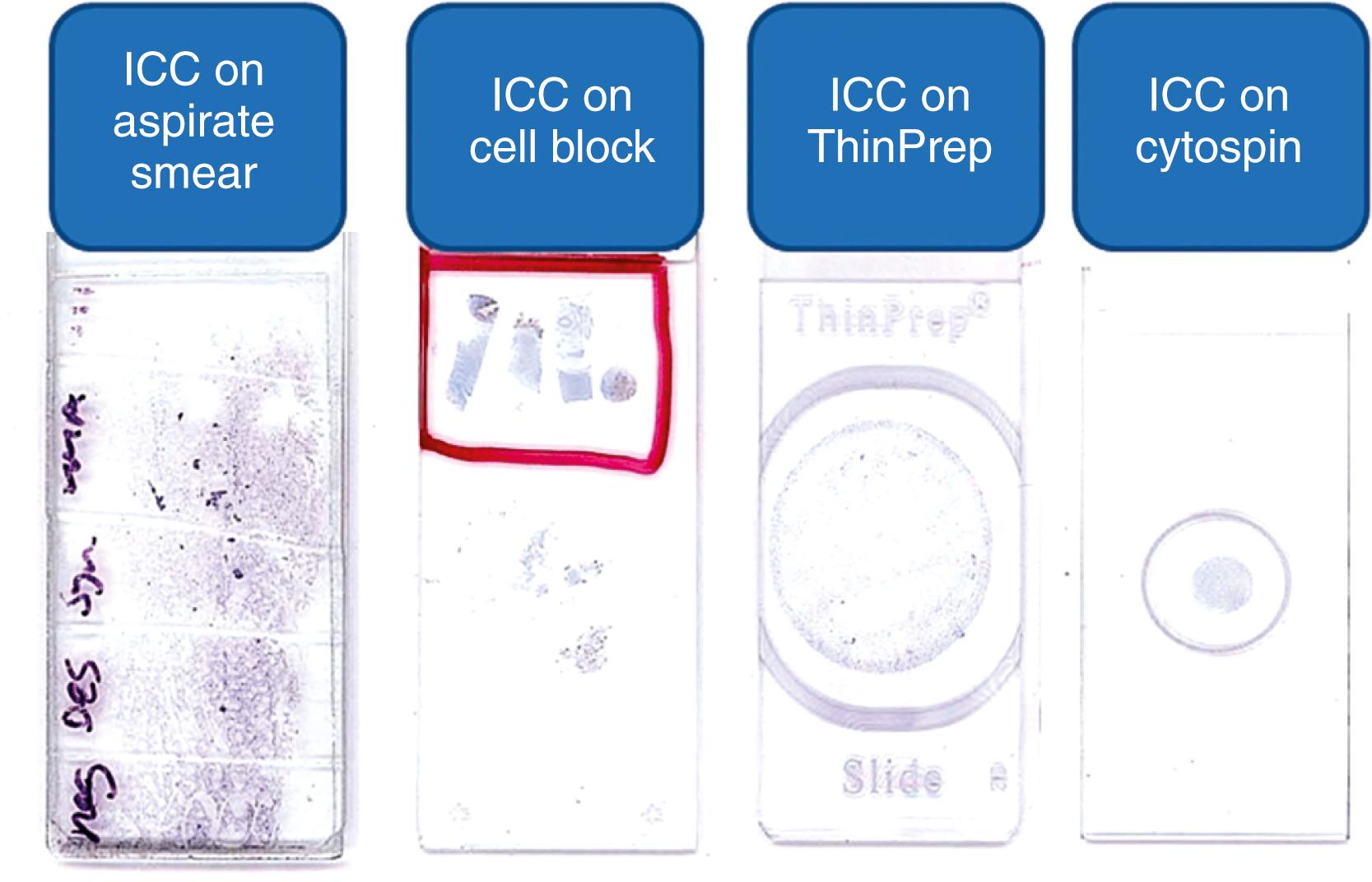
ICC can be performed on whole cells in various cytologic preparations such as direct smears, cytospins, imprints/scrapes or liquid-based preps (LBC). ICC is frequently performed on CB sections mirroring IHC and as a result; it is not infrequent in the literature to site ICC on CBs as IHC. The most important feature is a thin, even layer of cells with minimal obscuring factors to avoid problems interpreting the stain results. Ideally the smears should be adequately spread with minimal pressure to avoid crushing of cells and minimize large, crowded cell clusters. Bloody smears may have high background staining, especially with peroxidase-labeling reagents. , Therefore, it is essential to lyse the red blood cells in blood rich specimens, especially for DS and cytospins. This can be accomplished by either pretreatment of the fresh sample with a lysing agent or rehydration of air-dried slides in normal saline to lyse blood prior to ICC, which can provide a cleaner background and crisper ICC. ICC can be successfully performed on either stained or unstained, air-dried or wet-fixed preps. ICC performed on Papanicolaou stained preps without decolorizing produce better results. Although some postulate the use of graded alcohol and decolorization in acid bath to remove proteinaceous background, this process results in very focal staining and requires great scrutiny when examining the prep.
Direct smears (DS) prepared from fresh samples are helpful for ICC when no other material is available. While technically easy to prepare, limited material is available for a panel of markers and requires a large amount of reagents to cover the slide. DS perform well for nuclear stains such as TTF; however, cytoplasmic stains tend to be more difficult to interpret because of the high background staining caused by cell damage induced by smearing.
Cytospins are prepared from cell suspensions collected in non-fixative solutions such as normal saline, RPMI, etc. Cytospins are also helpful when there is no CB or other material available, and given the limited material needed, several cytospin slides can be generated from a small sample for a panel of immunostains. It is considered the best choice for lymphoid samples. The technique is generally useful for most antibodies, although reports vary due to the various fixatives and antibody dilutions used. High background staining can be seen in specimens rich in blood or mucus and pretreatment with mucolytic or hemolytic agents prior to ICC is essential. Cytospins are less than optimal for effusions as their protein-rich environment tends to induce high background, and at times, nonspecific staining. This is particularly noticed in 3-dimentional (3-D) clusters stained with E-cadherin and calretinin. Diffuse cytoplasmic staining was noted when membranous staining was expected. The technique is relatively labor-intensive but requires minimal amounts of reagents.
LBC or thin-layer techniques can also be used for ICC and have achieved good immunostaining results by using the proprietary solutions CytoLyt and PreservCyt (Hologic, Marlboro, MA) with or without processing on the ThinPrep processor. The methanol based collecting media also contains hemolytic and mucolytic agents. Even with long-term storage in PreservCyt, immunostaining is crisp, the background is cleaner than with DS, and immunoreactivity is stable. It is crucial that the immunostaining pattern is validated to the standard formalin protocol to ensure optimum results, and appropriate PreservCyt fixed controls should be used. Studies have shown that immunostaining for hormone receptors and Her2 on alcohol-fixed ThinPrep specimens correlated with the results on formalin-fixed paraffin-embedded (FFPE) tissue, but primary formalin fixation in CBs is critical as discussed below. , , While the majority of antigens can be easily demonstrated on LBC, some antibodies can be affected by alcohol fixation, and methanol is not considered suitable to preserve lymphoma markers. , , In a verification study of ICC performed on 71 FNA ThinPrep after validation, the authors reported that most antibodies performed reliably except for seven antibodies that were unreliable (calretinin, CD5, c-kit/CD117, inhibin, napsin A, Oct 3/4 and PAX 5) despite consistent IHC staining on concurrent surgical specimens. Information on SurePath preps is limited. A trial conducted by Hansen et al. to develop an applicable method to collect, process, and store SurePath preps found that unstained, air-dried slides prepared from specimens collected in CytoRich Red™ and stored at 5°C had preserved antigenicity and cellular components reacted as expected with relevant antibodies. Slides retained antigenicity up to 40 days.
CBs are all-purpose cellular material that can be used for special stains and for ICC (see Figs. 21.1 and 21.2 ). Similar to their paraffin-embedded histology specimen counterparts, CBs can withstand the processing protocols. In addition to the obvious advantage in studying the tissue architecture, additional tissue sections can be cut for ICC panels, and the paraffin blocks are robust ways to preserve tissue for up to about 25 years. This provides long-term storage option if additional theranostic studies or research is needed years after the biopsy. Ten percent neutral phosphate-buffered formalin (NBF) is used for fixation of tissue fragments. Interpretation of the results and storage of the specimen are easier, and antigen preservation is unlimited; for these reasons, CBs are the superior method for immunohistochemistry (IHC) for cytologic specimens. CB specimens can be collected directly into formalin or an alternative solution (e.g., RPMI salt solution, CytoLyt, other preservative). Various techniques have been used to prepare and optimize the CB cellularity; the sample can be treated with a commercial thrombin-plasma agent to organize a clot, collected in colloidal bag, or treated with HistoGel to create a pellet, and then fixed in 10% formalin and processed in a manner similar to that of small tissue biopsies. , The main disadvantage of using CBs for ICC is that there is no way to assess CB cellularity on-site, and thus there may be a lack of sufficient cells of interest within the block for immunostaining. Jing et al. evaluated the effect of sample collection in CytoLyt prior to CB processing and formalin fixation. The authors found no difference in ICC when compared with freshly collected samples except for cleaner and crisper staining in the former group. Specimens collected in CytoLyt and PreserveCyt (methanol-based) or CytoRich Red (ethanol-based) that are post-fixed in formalin should still be validated for IHC protocols.
The first fully automated rapid cell block (RCB) system introduced was Cellient (Hologic, Marlborough, MA), which has been shown to increase overall cellularity in the resulting sections with decreased time and a necessity for fewer reagents to make a CB. A proprietary tissue cassette and filter assembly designed to capture tissue fragments also permits them to be positioned in a plane for microtomy ( Fig. 21.3 ). Small aliquots of xylene, alcohol, and paraffin are rapidly drawn through the sample to produce a broad, uniform layer of cells embedded in paraffin. The RCB produces a CB in 15 minutes from residual ThinPrep vials or other specimens and can be used for a variety of gynecologic and respiratory tissues, FNA biopsies, body fluids, and other materials. If formalin is not used as the primary fixative, the alternative fixative must be validated against the formalin-fixed specimen, and controls must be used that have been fixed in the alternative material. In addition, the cost of the equipment can be a limiting factor for some institutions. In a recent validation study using 30 antibodies performed on the Cellient CB, 13/30 antibodies did not meet initial validation criteria. With process optimization, 8/13 antibodies were validated; however, despite several alterations, 3/13 antibodies (Ber-Ep4, D2-40 and PAX8) did not meet the validation criteria.
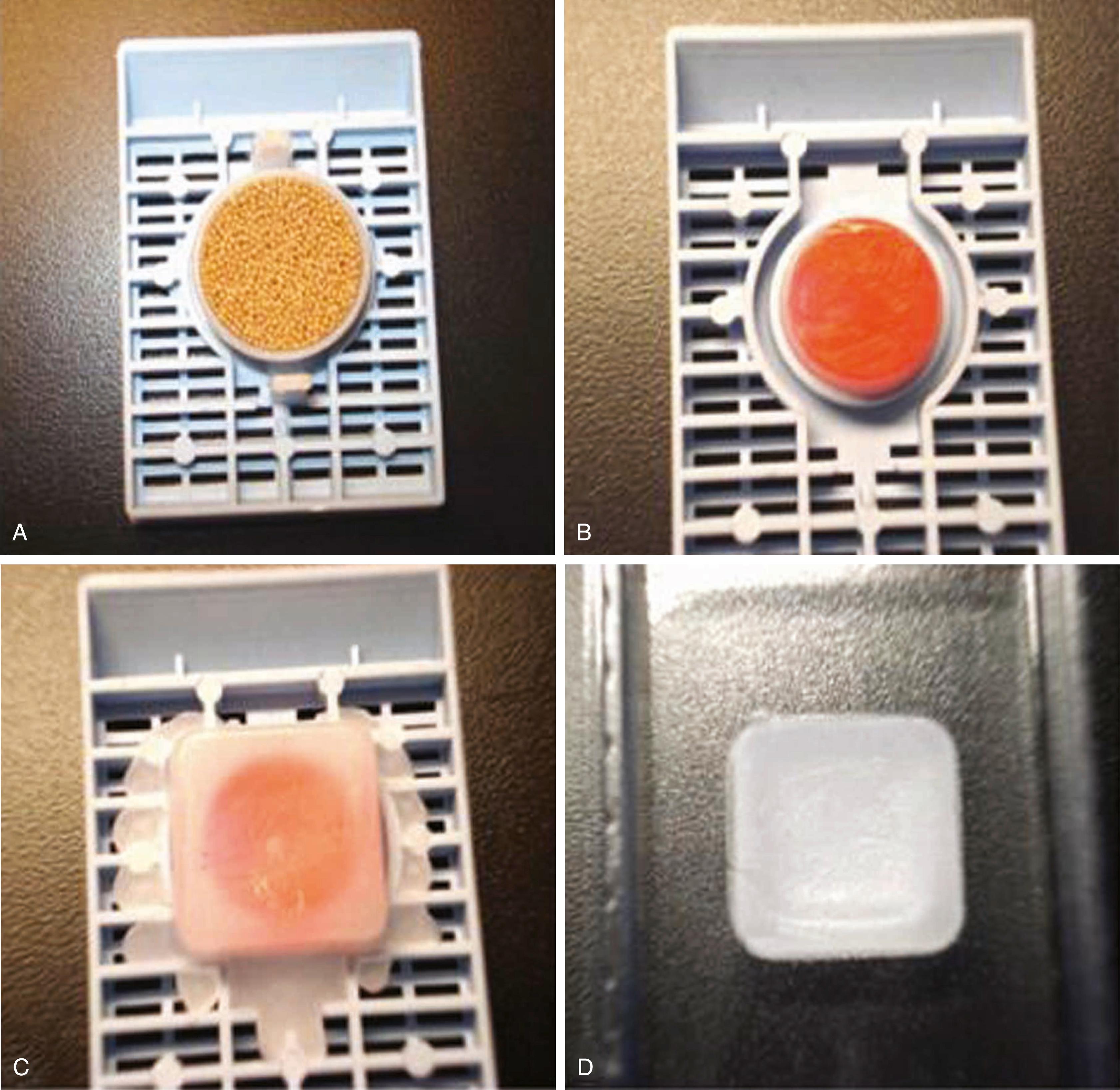
The use of cytoscrape cell blocks (SCBs) is another technique to prepare CBs, especially from stained FNA smears. This technique is useful when cell groups are obscured by clotted blood or when overlapping cell clusters interfere with the cytologic details and make interpretation difficult. The method involves previously stained smears that contain thick material in which the coverslip is removed with xylene. The slides are passed through two changes of absolute alcohol and water. Papanicolaou-stained smears are destained by 1% acid alcohol, whereas Romanowsky-stained smears are destained by 2% glacial acetic acid. The smears are then thoroughly rinsed in running tap water for two hours. Slides are carefully scraped with a scalpel blade, and the scraped material is meticulously transferred with forceps in 3% molten agar to form a small button. After the agar solidifies, it is wrapped in Whatman filter paper No. 1 and put in a tissue cassette. The scraped material is re-fixed in a histologic fixative, such as Bouin fluid or formal saline, for five to six hours and is routinely processed to make a paraffin wax block. Sections of 5 μm are cut and stained with hematoxylin and eosin. A study that compared SCBs with conventional CBs found that cytomorphologic details are equally superior in both types of specimen samples. An added advantage with this method is that additional panels of immunostains can be performed on SCBs, particularly when no CB is available, and repeat FNA is not feasible.
Although CBs are commonly and routinely used in non-gynecologic cytopathology, they can also be helpful in cervicovaginal cytology. The utility of CBs prepared from residual material from Pap tests has been reported to be helpful for morphologic evaluation and ICC and for molecular studies. CBs can be useful for identifying a high-grade squamous intraepithelial lesion (HSIL) and glandular abnormalities in addition to differentiating between atrophy and metaplasia. The diagnostic sensitivity and specificity of CBs from the residual samples have been shown to range from 86% to 100%. Another important use of CBs is for performing ICC when the Pap test interpretation is equivocal. A few studies have demonstrated the performance of IHC stains on CBs. A study that looked at the utility of p16 on CBs obtained from the residual samples found that the sensitivity of this immunostain was as high as 85% in Pap tests with a diagnosis of atypical squamous cells, cannot exclude HSIL (ASC-H); another similar study that used p16 and MIB-1 (Ki-67) found the concordance of Pap test and CB interpretation to be as high as 85% ; thus it is important to recognize the growing importance of CB preparations in cervicovaginal cytology.
Some cytologic preparations are not suitable for ICC. This category includes filter preparations because the filter can detach from the slide and absorb the immunologic reagents and the chromogen, leading to high background staining. In addition, fluids with abundant mucoid material, necrosis, blood, or high protein content may have a precipitate that prevents penetration of reagents; thus, these specimens may benefit from an additional washing step or from the use of an alternative preparation for ICC such as a ThinPrep specimen that can help to minimize obscuring blood.
Some of the important prerequisites for optimal ICC results include well-prepared material, that is, a thin and uniform spread of cells with adequate fixation; minimal obscuring factors (e.g., necrosis, blood, mucus, and proteinaceous material); and a reproducible quality-controlled method of ICC. , Wet fixation in alcohol (WFA) must be performed without delay because air drying may result in distortion and false-positive results. Similarly, air drying of wet-fixed smears prior to ICC may result in inconsistent results. An air-dried smear (ADS) is often more cellular than an alcohol-fixed slide because some material often floats off the slide when it is alcohol fixed. Such air-dried slides must be fixed immediately before performing ICC, and the types of preferred fixatives vary among cytopathologists and different institutions. Cold acetone, formalin, CytoLyt, and 95% alcohol are commonly used fixatives. , Of all the specimens and fixatives, FFPE CBs using 10% NBF at a pH of 5 to 7 provides an optimal specimen for ICC because of better specimen standardization, and thus they are commonly used in most institutions. , A list of common fixatives and quality of the resultant specimen is provided in Table 21.1 .
| Fixative | Description of Fixative | DNA Quality | RNA Quality |
|---|---|---|---|
| Ethanol (includes BD SurePath solution) | 70%–100% ethanol (ethyl alcohol) | Good | Good |
| ThinPrep (with CytoLyt and PreservCyt) | Methanol-based buffered solution | Good | Good |
| CytoRich Red/Blue | Ethanol-based solution CytoRich Blue preserves the red blood cells |
Good | Good |
| RPMI medium | Cell culture media with sodium bicarbonate | Good | Good |
| Neutral buffered formalin | Formaldehyde, phosphate buffers | Good-Fair | Good-Fair |
| Bouin’s | Picric acid, formaldehyde, and glacial acetic acid | Poor | Poor |
| Decalcifying agents | Weak acids (picric, acetic, and formic acid), strong acids (nitric and hydrochloric acid), or chelating agents (EDTA) a | Poor | Poor |
| B-5 | Mercuric chloride, sodium acetate anhydrous | Poor | Poor |
a EDTA may yield higher quality DNA suitable for molecular studies, and less DNA degradation than samples decalcified with formic acid agents.
Suthipintawong et al. evaluated 23 fixation protocols using various combinations of acetone, methanol, ethanol, and formal saline. While immediate fixation in ethanol, especially without air-drying, provided good antigen presentation, it also produced very high background staining. Similarly, ethanol-fixed slides post-fixed in formal saline produced high background. The best and most consistent results were produced by ADSs fixed in 0.1% formal saline (also known as van der Griendt fluid) and post-fixed in 100% ethanol. Erythrocytes can be hemolysed with formal saline, resulting in a clean background. Better results were obtained when slides were fixed longer, especially in blood-rich samples, since it allowed more complete hemolysis. All acetone-based fixatives gave inconsistent results. It is worth noting that immunoreactivity for S-100 protein was poor for all fixatives except formalin-based ones.
A study by Fulciniti and associates has shown that formalin post-fixed ADSs are reliable and better than the standard wet-fixed smears. The study proposed that the slow dehydration and short rehydration might contribute to a superior interpretation of the results. Our experience showed similar results with preparations that were relatively free of background blood and mucus. In general, nuclear antigens are best detected when ADSs are fixed in 4% to 10% formalin. Ethan ethanol, ethanol-acetone, ethanol:methanol, or combination of those fixatives has been reported to result in less reproducible staining for nuclear epitopes. Additional studies confirmed the superior results with formalin-fixed ADSs. , While acetone is considered the best fixative for lymphoma markers, it is not suitable for non-hematopoietic markers. , , ,
An important point to keep in mind is that certain antibodies—for example, S100 protein, HepPar-1, estrogen receptor (ER), and gross cystic disease fluid protein 15 (GCDFP-15)—may be leached from alcohol fixatives and render false-negative results. , For instance, ER staining on FNA smears by using different methods has shown that destaining the slides with alcohol before immunostaining significantly reduces the number of cells with positive nuclear staining. The available anti-ER antibodies (SP1, ID5, 6F11) perform best with 10% NBF for hormone fixation, as do other immunostains. In addition, S100 protein can show false-negative or decreased staining with alcohol fixation, as shown in the case of malignant melanoma involving the biliary tract in Fig. 21.4 .
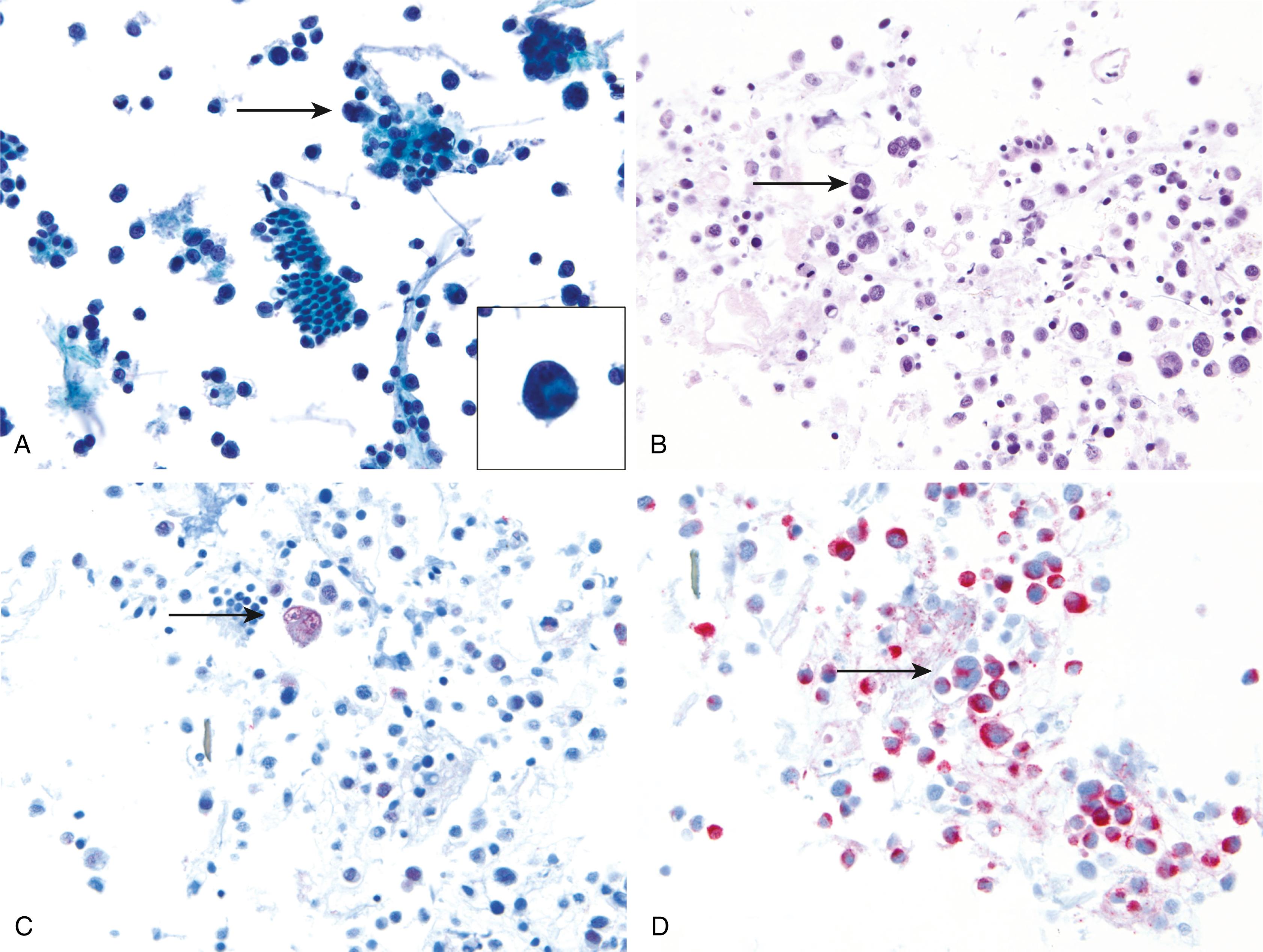
An example that illustrates the importance of fixation is the evaluation of breast carcinoma. ERs and progesterone receptors (PRs) and over-expression of ERBB2 are important prognostic and predictive markers of breast carcinoma. The recommendation by the 2010 and 2013 American Society of Clinical Oncology (ASCO) and College of American Pathologists (CAP) for hormone receptor testing highlighted the importance of an accurate and reproducible assay with optimal tissue handling. The need for standardizing preanalytical variables is now well recognized, particularly tissue fixation, including the time to fixation (i.e., cold ischemic time), type of fixative, and duration of tissue fixation. , Under-fixation of tissue cannot be repaired and is the least desirable result of handling tissues in the anatomic pathology laboratory. No amount of antigen retrieval can resurrect a tissue that is under-fixed. Antigens will be lost, and false negatives will abound in such situations, regardless of the quality of instrumentation. Over-fixation, on the other hand, may result in a specimen needing changes in antigen retrieval, antibody titer, and detection systems. , The optimal result is to have a standard fixation time, ideally one that is unique for every antigen the pathologist is attempting to detect. For example, per the ASCO/CAP guidelines, the recommended minimum fixation in 10% NBF for hormone receptors is no less than 6 hours and no more than 72 hours, and usually approximately 24 hours is optimal. Routinely processed cytologic specimens fixed in formalin can also be used to assess the receptor status and HER2 protein by IHC.
One of the advantages of using cytologic specimens for immunostaining is that there is limited prefixation time in most cases, especially if on-site evaluation is used for FNAs, given that needles can be rinsed directly into formalin or other fixative. This is helpful given that the ASCO/CAP guidelines recommend limiting prefixation time to under 1 hour to minimize the degradation of nucleic acids and proteins in the tissue. Some of the effects of delayed fixation would include loss of immunostaining from degraded proteins, in addition to the loss of mitotic figures resulting in a falsely low proliferation index and inaccurate grading of tumors. In addition, although a fixation time of approximately 24 hours is preferred (range, 6 to 72 hours), efforts to reduce fixation time include the use of heated fixation. Another important aspect of fixation that is usually not an issue in cytology is fixative penetration given that the amount of cellular material is usually drastically less than the amount of fixative present. This penetration is more of a concern in surgical pathology, where a 1:10 (range, 1:1 to 1:20) ratio of tissue to fixative is preferred for surgical specimens to optimize fixation.
The history of standardization attempts is long, and it has been well discussed by Clive Taylor, beginning with his transactions on the Biological Stain Commission and continuing into detailed discussions about the “total test concept” of the IHC tests (see also Chapter 1 ). , The Biologic Stain Commission was one of the original agencies to oversee the special stains used in the anatomic pathology laboratory. The agencies that followed include the Clinical Laboratory Standards Institute (CLSI, previously NCCLS), the Food and Drug Administration (FDA), and commissions set up by professional organizations, including CAP. The emphasis of all these organizations has been on consistent, quality assay components for IHC. The consequence of all this work has resulted in the package inserts that accompany various IHC reagents. Despite all this work, there are still many preanalytical variables that have not been adequately addressed. In fact, in one paper from 2011, only 44% of the 61 preanalytical variables had published results, whereas the remaining did not have clear-cut evidence from the literature.
The process of validation should confirm that the test of interest results in the same expected level of sensitivity, specificity, and reproducibility as intended, and results should be compared to a known gold standard. The gold standard use can be one of the following: (1) compare the morphology and results to those published in the medical literature, (2) results of a previously validated assay from the same laboratory, (3) another laboratory’s results such as those published by the interlaboratory comparison, and (4) result from a well validated non-immunohistochemistry assay, for example, FISH. The CAP guidelines require a concordance level of at least 90%. The CAP mandates testing size of at least 20 cases for diagnostic markers and 40 cases for predictive and prognostic markers. In addition to the positive controls, the validation set should include adequate number of cases that should be negative for the tested analyte. Since the various pre-analytic conditions, such as method of preparation, fixation, and antigen retrieval, can all affect the spatial distribution of the antigen and subsequently the IHC/ICC results, the controls used should be prepared in the same manner and conditions as those of the tested ones—that is, FFPE CBs with FFPE tissue sections controls, alcohol fixed DS controls for alcohol fixed DS test specimen, etc. Staining protocols validated for FFPE sections should be optimized for cytology preparations and proper adjustment or antibody concentration, pretreatment, etc., adjusted to yield best results. The CAP recognizes the challenge posed on the cytology laboratory to meet these standards and recommends that reasonable efforts should be made to assure that the implemented assays perform as expected before implementation in clinical practice. The selection of the markers studies and the number of cases included in these separate validation studies are to be determined by the laboratory medical director. Furthermore, most of the established articles on preanalytical standardization focus on surgical pathology specimens, not cytology specimens, and thus there is a paucity of data on all the preanalytical variables in cytopathology. While automated staining is reliable and cytology specimens can be treated in the same manner as tissue samples, manual staining can be difficult to fully standardize and monitor due to the variation among the technicians. As a result, it is recommended to keep the number of technicians involved in manual staining limited to allow adequate case load and experience, which can reduce variations.
A study by members of the Ad Hoc Committee on Immunohistochemistry Standardization recommended formalin fixative as the standard for IHC testing, along with a minimum of 6 hours of fixative time for prognostic/predictive markers, including ER, PR, and HER2. , , These guidelines have been incorporated by the ASCO/CAP guidelines for breast cancer hormone receptor testing , and follow the simple fact that all clinically validated studies on ER, PR, and HER2 antibodies have been performed on FFPE tissue. Alcohol fixatives may result in spurious results for certain antibodies, such as S100, HepPar-1, hormone receptors, and Her2/neu, as noted earlier; thus alcohol fixative is not recommended for evaluation of these markers. , Although alcohol fixatives can be used for other antibodies, it is imperative for the laboratory director to validate protocols and use appropriate alcohol-based controls if alcohol fixation of cytologic specimens is used. FFPE CBs are the preferred samples for IHC in most laboratories for the reasons discussed, and with the FFPE cytology CBs, standardization protocols for surgical specimens can be easily applied to cytology specimens.
Air-dried slides and partially fixed air-dried slides can be rehydrated in normal saline to optimize immunoreactivity as well as cytomorphology. Chan and Kung found that the optimal time for rehydration is less than 1 minute, provided that the air-drying time did not exceed 30 minutes. Shidham et al. tested the effect of postponing rehydration and staining of air-dried smears for 72 hours and found that the cytomorphology, and fungal stains were comparable to those immediately rehydrated. This procedure offers the flexibility to select various staining methods and may be used when cytomorphology is critically important because air-dried slides can sit for up to 1 week at room temperature and still be used for ICC, provided they are fixed immediately before use, as already described. Slides for ICC, whether air dried or fixed, can be stored at −70°C for at least 1 month, and reportedly for years, and still maintain immunoreactivity. , It is recommended to store the slides in small plastic boxes, and that they are allowed to equilibrate to room temperature in the boxes prior to staining. Liquid-based suspensions are preferably stored in their original fixative solution.
One of the important methods through which standardization of IHC can be achieved is antigen retrieval. An ideal antigen-retrieval technique is considered to maintain formalin as a standard fixative for both morphology and IHC. High-temperature heating is the most crucial step in this methodology to retrieve the antigens masked by formalin fixation. However, simple methods such as immersing in water or an NaOH-methanol solution will yield dramatic retrieval results. Although use of metal ions with zinc and lead in the antigen retrieval solutions has shown improved results in many studies, their environmental toxicity has given way to alternatives such as citrate, Tris, urea, and ethylenediaminetetraacetic acid (EDTA). Antigen retrieval has been widely used for detection of ER, PR, MIB-1, p53, Bcl-2, retinoblastoma gene (pRB) , and some cluster designation (CD) markers. Although the literature on the subject of use of antigen retrieval on cytology specimens is still evolving, some important studies have successfully shown that antigen retrieval can be applied to these specimens for a wide range of antibodies. Results are satisfactory and are comparable to their tissue specimen counterparts. Sherman and colleagues have shown a method of “cell transfer” that can facilitate immunostaining on small samples. In a study that compared the effects of heat (with a pressure cooker) on air-dried versus alcohol-fixed smears for cytokeratins AE1/AE3, 7, and 20; neurofibrillary protein (NFP); synaptophysin; ER (clone ID5) and PR (clone 1294); and vimentin, it was found that ADS results improved with antigen retrieval. Furthermore, alcohol-fixed smears can be successfully immunostained without antigen retrieval, since the membrane bound and cytoplasmic antigens are readily accessible, or with mild heat-induced antigen retrieval by citrate buffer. Nuclear antigens require heat induced antigen retrieval. , Miller and associates found that FNA biopsy material studied through tissue transfer to adhesive slides followed by antigen retrieval using the same conditions as for routine paraffin sections substantially improved the ease of interpretation, especially in the ADSs.
As previously mentioned, both positive and negative controls must be performed with each test sample, and controls have to be prepared in the same manner and treated with the same conditions of the test sample that rendered the CBs the most used method. Cytology controls can be obtained daily from the surgical pathology bench with the use of aspirates or direct imprints. Additional sources included excess material that will be discarded and well-characterized cell lines. Obviously it is a very cumbersome practice for a laboratory to prepare controls for different cytology preparations and different fixatives. It is more practical to use cells on the cytology slide as a positive or negative internal control depending on the antibody and cells present. In a meta-analysis of the use of controls in cytopathology articles, only 13% of articles described the use of positive and negative controls run on identically prepared samples. This finding suggests that there should be more stringent documentation of appropriate controls in cytopathology on par with that seen in surgical pathology.
ICC can be hampered by a limited quantity of the specimen, which happens more often in cytopathology than surgical pathology. Pathologists continue to optimize the CB methodology to limit cell loss during preparation and enhance aggregation and visualization of the limited cells , Some of the ways to overcome limited specimens include appropriately triaging the material for the studies needed, cutting blank slides from a CB upfront to avoid trimming the block, using alternative material if available, appropriately selecting the important studies needed, and performing multiplex staining for ICC. For example, in scenarios of scant cellularity on a CB, aspirate smears or other material may be used (see Fig. 21.2 ). In addition, dual immunolabeling may be performed on the same slide instead of on separate slides, or even more antibodies may be multiplexed on the same slide, which will maximize the immunomarkers that can be used on smaller amounts of material. Some of the ways to maximize the cytologic material available for ICC are summarized in Box 21.2 .
Educate those who obtain the biopsies about the importance of procuring sufficient tissue.
Select the optimal type of specimen (exfoliative or aspiration cytology).
Ensure rapid on-site assessment by cytologists for adequacy assessment and appropriate triage.
Select appropriate fixative and processing by avoiding certain fixatives for certain antibodies.
Acquire additional dedicated material for ancillary studies, such as dedicated passes for cell block.
Establish, validate, and standardize laboratory protocol for processing and evaluation of samples.
Cut extra blank slides up front in an effort to conserve tissue and triage the blank slides for the appropriate stains.
Limit immunoperoxidase staining panels.
Use alternative material in cases with insufficient tissue in the cell block (e.g., aspirate smear material).
Use alternative procedures in cases of scant material, such as dual immunostaining or multiplex immunostaining.
Optimize and assess specimen processing with appropriate quality assurance.
In one study, Abendroth and Dabbs described a double-labeling method to address the problem of limited material when more than one antibody is required to make a diagnosis. Immunostaining was performed on these slides with and without a preceding decolorization step, and the results were similar, with good immunostain results. Background staining was more of a problem on the air-dried, unfixed cases. Thus recently stained or archived cytology slides can be used for ICC studies. Dual staining has also been shown in other studies in which more than one antibody, typically a nuclear and cytoplasmic or membranous stain, is used on the same slide as opposed to separate slides. Cytologic material can also be used in a variation of the dual immunolabeling technique. , Cytology slides that were subjected to an immunoperoxidase stain and produced a negative result can also be subjected to another immunoperoxidase test using a different antibody. It is imperative to use positive and negative controls with both test runs. For example, a poorly differentiated tumor found to be negative for LCA can then be tested with cytokeratin to determine whether it is an epithelial tumor. Antibodies that have been used with this method include CAM5.2, AE1/AE3, 34βE12, GCDFP-15, vimentin, CD20, CD45RO, muscle-specific actin (HHF-35), desmin, CEA, and S100. Additionally, more than one antibody can be performed on the same slide. Up to four antibodies can be applied on a single ThinPrep. The slide is divided in half using a diamond knife, and each half is partitioned with wax crayon. Following antibody incubation, the two halves can be glued together on a conventional slide. , This technique is cost-effective and best suited for LBC since the cells are equally distributed in all quadrants.
As previously described, cells can be scraped from slides and collected in a nylon mesh sample bag from which a CB can be prepared or stretched and mounted on several slides. , , In the latter technique, cells are lifted off the slide by redissolving them in a new mounting medium. The medium can be removed from the slide, cut into pieces, and reapplied to slides for individual antibody studies. The results of immunostains are generally good, although Hunt and colleagues described some decreased staining with this method. In the future, multiplex staining with multiple antibodies on a single slide may help to minimize the tissue needed for ICC and maximize the results.
Small specimens can also be difficult to interpret due to equivocal or nonspecific staining, false-negative staining due to different fixatives, folded tissue, and other problems, which are discussed more in detail in the “Pitfalls in Immunocytochemistry” section (see Figs. 21.4 and 21.5 ).
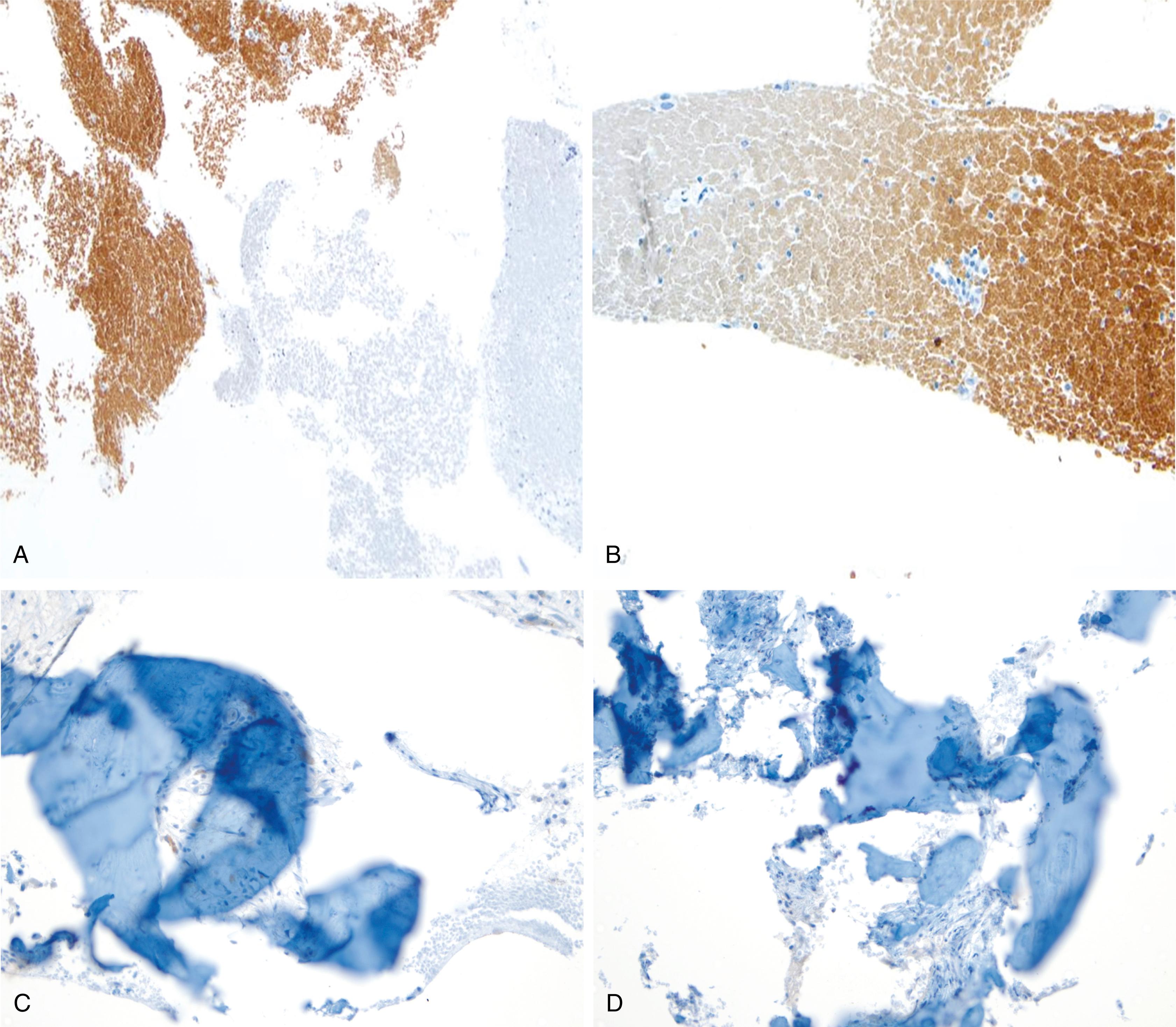
Effusion cytology is one of the most challenging areas of cytopathology, wherein ICC serves as a valuable adjunct tool in definitive interpretation. Immunostains are critical to distinguish reactive mesothelial cells from carcinomas that involve body cavity fluids because mesothelial cells can show significant atypia that mimics adenocarcinomas and other malignancies. In the absence of these studies, the sensitivity for the detection of malignant cells has been reported to be as low as 40%. Though less commonly encountered, ICC is essential in establishing the diagnosis of malignant mesothelioma, which frequently manifest as an effusion.
Normal fluid specimens contain mesothelial cells, which can exhibit a spectrum of cytomorphologic features that include changes that can mimic malignancy and features that can mimic bland-appearing neoplasms; this makes it difficult to recognize the foreign (i.e., neoplastic) population; thus ICC plays an important role in the identification of reactive mesothelial cells from adenocarcinoma. Several studies have highlighted and proposed panels of antibodies to resolve this issue. These studies indicate that combining the cytomorphologic evaluation with the results of a panel of antibodies that comprises both mesothelial and adenocarcinoma markers can significantly improve diagnostic accuracy. , , Mesothelioma cells may not always be easily distinguished from carcinoma. For those cases, it is recommended to use a panel with two stains for mesothelium and two stains for carcinoma.
Effusions are unique since the fluids are naturally rich in proteins and nutrients that allow the cells to survive relatively longer at room temperature or long storage. Studies evaluating the effect of storage at 4°C and 37°C found minor differences between the two storage conditions at day 4 and immunogenicity and amplifiable DNA was preserved up to day 14 in samples stored at 4°C. ,
ICC can be performed on a variety of preparations from fluid specimens, such as CBs, DS, cytospins, and LBC preparations (see Fig. 21.2 ). Storage of effusions at 4°C gives a satisfactory IHC outcome when a delay in processing of the samples is anticipated. In our experience, optimal results are achieved when ICC is performed on 10% NBF cell-block material because the immunoreactivity pattern may be changed by different fixation methods.
A 29-kDa calcium-binding protein that is a member of the elongation factor (EF) family of proteins, calretinin, is thought to play a role in the cell cycle and is helpful in confirming cells of mesothelial origin, but it does not distinguish benign or reactive mesothelial cells from malignant mesothelial cells (i.e., mesothelioma; Fig. 21.6 ). Gotzos and colleagues were the first to report its expression by epithelioid mesotheliomas and epithelioid components of mixed mesotheliomas, and they reported negative results in adenocarcinoma. These results were later confirmed by studies that showed only rare focal positivity, primarily as a cytoplasmic blush, in a variety of carcinomas that included 10% to 30% of adenocarcinomas. , It is worth noting that calretinin is expressed in 38% of triple negative breast carcinoma, and therefore an additional mesothelial marker would be recommended in that differential. The sensitivity of calretinin to distinguish reactive mesothelial cells from adenocarcinoma cells approaches 100%, and the specificity is as high as 80%. Interpretation of this marker is based on finding strong nuclear and cytoplasmic positivity in the cells of interest (see Fig. 21.6C ). ,
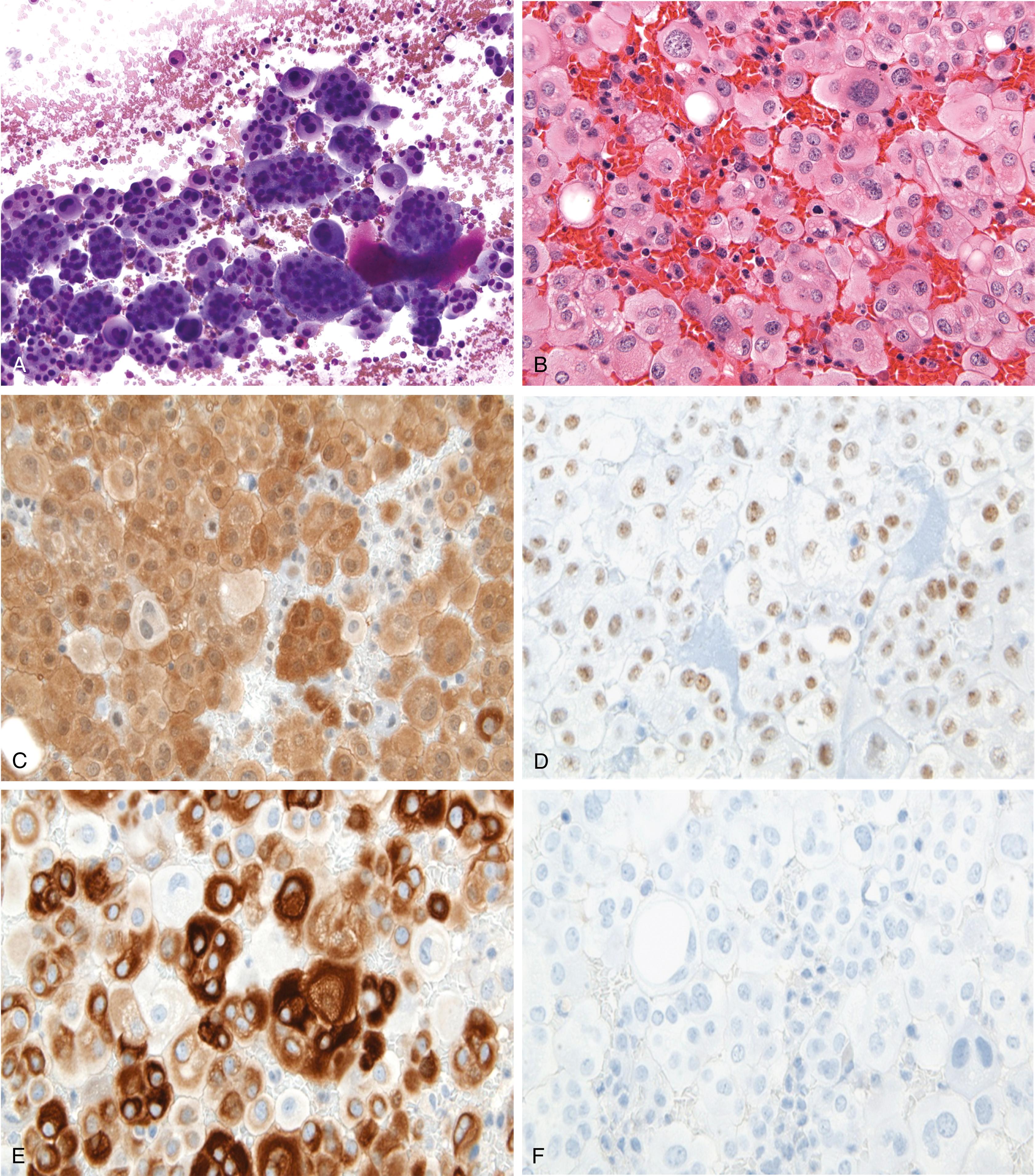
Ordóñez demonstrated a difference in sensitivities of the human recombinant antibodies from Zymed and a guinea pig calretinin from Chemicon. The Zymed antibody sensitivity was 100% compared with a Chemicon sensitivity of 74%. Focal, weak staining of adenocarcinoma was seen in 4% and 9%, respectively. Nagel and colleagues had a similar experience with the study of cytospins. They found that the sensitivity for mesothelial cells was 93%, with 5% of tumor cells immunostaining. In a study by Yaziji and associates, calretinin was one of three antibodies, along with Bg8 and MOC-31, identified in the evaluation of a 12-antibody panel, which was cited to be the most efficient panel for distinguishing epithelioid mesothelioma from adenocarcinoma.
Keratin 5 was found to be a constituent of mesothelioma but not lung adenocarcinoma in a few early studies, , which was confirmed later in larger series that reported only focal staining in less than 10% of adenocarcinomas. Diffuse cytoplasmic staining is seen in almost all mesothelial cells, including mesotheliomas, in addition to squamous cell carcinomas. , The sensitivity and specificity of this stain in distinguishing malignant mesothelioma from adenocarcinoma in pleural effusions is 90% to 100%. However, this marker is of no value in differentiating mesothelial cells from metastatic pulmonary squamous cell carcinoma because squamous cells are also positive for CK5/6. It is important to keep in mind that certain breast carcinomas, particularly tumors with a basal phenotype, also express CK5/6. Given these data, CK5/6 is only useful for differentiating epithelioid malignant mesothelioma and reactive mesothelial cells from adenocarcinoma. Mesothelial cells are also positive for CK7; however, this cytokeratin is also positive in many metastatic adenocarcinomas and is, therefore, not helpful in making the distinction between mesothelial cells and metastatic adenocarcinoma (see Fig. 21.6E ).
The Wilms tumor gene, WT1, is a tumor suppressor gene present on chromosome 11, and it is a helpful mesothelial marker in that it shows nuclear positivity (see Fig. 21.6D ). It was first reported as a candidate for the main gene in the development of Wilms tumor. , The IHC expression of WT1 can be seen in a variety of neoplasms, such as serous tumors of the ovary, leukemia, desmoplastic small round cell tumors, and others. In addition, a majority of epithelioid mesotheliomas and a small percentage of sarcomatoid mesotheliomas express WT1, which represents an effective marker for mesotheliomas and reactive mesothelial cells in CB preparations, and this can aid in the distinction of mesothelioma from pulmonary adenocarcinoma. WT1 is also a highly sensitive and specific marker for carcinomas of müllerian origin; therefore, the pathologist should exercise caution when a metastatic carcinoma is of the ovarian serous type because strong nuclear positivity will be seen in serous tumors and mesothelial cells.
D2-40 was initially reported to be a marker for lymphatic endothelium but was found to be expressed by benign and neoplastic mesothelial cells. As with WT1, D2-40 is a sensitive marker, and was found to be a highly sensitive and specific marker (up to 100%) for malignant mesothelioma. Therefore, it can be used in a panel to distinguish mesothelioma or mesothelial cells from pulmonary carcinomas in effusion cytology specimens. However, D2-40 expression has also been reported in approximately 50% of ovarian carcinomas, 30% of lung carcinomas, and 30% of breast carcinomas. In addition, the pattern of staining in the ovarian tumors was strong and was similar to the staining seen in mesothelial cells, leading some to believe that it is not a useful stain, particularly if an ovarian tumor is a consideration, analogous To WT1.
Protein HEG homolog 1 recently emerged as a great mesothelial marker that tends to be always expressed in mesothelioma. HEG1 expression is believed to regulate the endothelial cell signaling pathway and that it supports the survival and proliferation of mesothelioma cells. It was reported as a mesothelioma related antigen with a 99% specificity and 92% sensitivity. Hiroshima et al. recently evaluated the utility of HEG1 in the workup of effusions and reported that it reacted with 41/41 mesotheliomas, 20/26 reactive mesothelium, and 6/21 ovarian carcinomas. HEG1 was nonreactive with all other carcinomas tested. Based on this data, it seems that HEG1 may be best used to distinguish mesothelioma from adenocarcinoma, except ovarian carcinoma but not to confirm malignancy of the mesothelial cells.
The mesothelial cell clone HBME1 is an antibody against cultured mesothelial cells and recognizes an antigen on the microvillus surface. HBME1 has been used as a part of the panel of ICC to distinguish adenocarcinoma from mesothelial cells. Interpretation of this stain is complex compared with calretinin. The staining pattern of mesothelial cells shows a thick, bushy membrane pattern and a thin membrane or cytoplasmic staining of adenocarcinoma. A gradient in the staining pattern was observed in malignant mesothelioma versus adenocarcinoma. The specificity of HBME1 as a mesothelial marker approaches 80%. Calretinin tends to be a preferred marker over HBME1 because of its superior sensitivity and specificity in most studies, and thus HBME1 is not commonly used in most laboratories.
Glucose transporter isoforms (GLUT)-1, a member of the family of GLUT, facilitates the entry of glucose into cells and is expressed in a variety of malignancies. Immunohistochemically, GLUT-1 expression is confirmed by membranous staining, sometimes with cytoplasmic staining. GLUT-1 has been reported to be a sensitive and specific IHC marker that can help to differentiate reactive mesothelial cells from malignant mesothelioma. It cannot, however, discriminate between malignant mesothelioma and other malignancies. , Thus ICC is required to confirm that the malignant population is mesothelial in origin in addition to using GLUT-1 as a proposed “malignancy marker.” In a comparison of GLUT-1 with fluorescence in situ hybridization (FISH) detection of the CDKN2A (formerly p16 ) gene deletion in mesothelioma, the deletion was found to be more sensitive and specific as a malignancy marker than immunostaining with GLUT-1. In effusions, GLUT-1 interpretation can be hindered by the reactive background red blood cells.
BAP1 (BRCA1-associated protein 1) is now considered a reliable marker of malignancy in mesothelial cells. The protein is encoded by the BAP1 gene at 3p21.1 and is involved in various cellular processes. BAP1 behaves as a true tumor suppressor gene. Germline mutations have been found in families with high incidence of mesothelioma and other neoplasms (autosomal dominant BAP1 syndrome). Sporadic loss of BAP1 has also been reported in several neoplasms including mesothelioma. When mutations in the BAP1 gene were discovered in mesotheliomas, it was also noted that this correlated with a loss of BAP1 immunostaining in cases with biallelic mutations and more often in cases of epithelioid mesotheliomas. Thus loss of BAP1 nuclear staining can be helpful evidence to support a malignant mesothelial population, but loss of staining will not be present in all cases of malignant mesothelioma, limiting its sensitivity to approximately 55% to 80%. By ICC, normal cells express BAP1 in the nuclei ( Fig. 21.7A ), whereas in malignant mesothelioma, the cells either completely lose the expression or show cytoplasmic expression of BAP1, which is thought to reflect loss of the nuclear localization. The BAP1-positive inflammatory cells help to provide an internal positive control in cytology fluid specimens ( Fig. 21.7B ). In tissue samples, BAP1 loss was reported in up to 74% of pleural epithelioid mesotheliomas and 42% to 57% of peritoneal mesotheliomas. Several studies evaluated the application of BAP1 in cytology samples and reported on the average a 58% and 100% sensitivity and specificity respectively. , Most mesotheliomas express total or near total loss of BAP1 expression; however, some cases were found to show partial expression. Hida recommended the use of greater than 19% as an indicator for malignancy. In effusions, BAP1 is particularly helpful in cases that show subtle cytologic atypia. It is currently considered a defining feature of “mesothelioma in situ,” an entity that is now recognized as a mesothelioma variant. Since most of these cases present with atypical effusions, BAP1 loss may play a great role in suggesting this diagnosis in effusions and is currently a topic of interest. Because somatic loss of BAP1 is rare in other malignancies, it can be helpful in separating mesothelioma from carcinoma when the immunoprofile is equivocal. , As discussed below, the combination of BAP1 and Claudin-4 can be very helpful in the differential of mesothelioma, reactive mesothelium, and carcinoma.
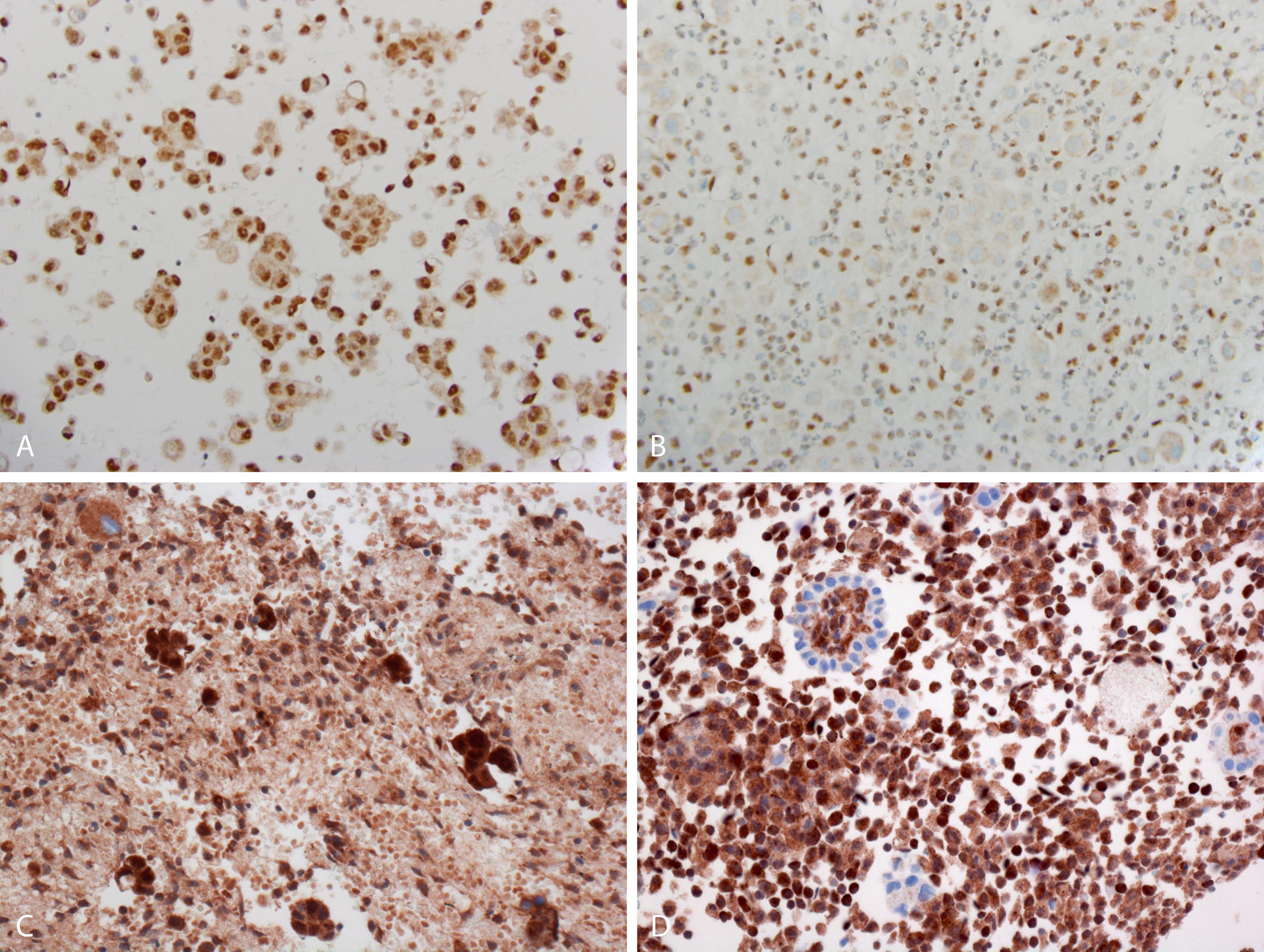
For accurate interpretation, only loss of nuclear staining is considered diagnostic, and the background inflammatory cells should be positive. BAP1 antigen is sensitive to fixatives and may leach in alcohol preparations making FFPE CBs more reliable.
Methylthioadenosine phosphorylase is a gene located within 200 KB of the CDKN2A gene that codes the p16 protein on chromosome 9p21.3. Both genes can be deleted in many malignancies aside from mesothelioma and, therefore, have to be judiciously interpreted in the appropriate context of proven mesothelial proliferation. MTAP protein is an enzyme involved in purine metabolism. Studies using FISH showed exact matching of loss or retention of the two genes in mesotheliomas. MTAP loss can be detected by immunostains, but its loss does not correspond with CDKN2A as well as by FISH, and correlation was reported in 74% to 82% of cases, with a 78% sensitivity and 96% specificity for homozygous deletion (HD) of CDKN2A detected by FISH. Hiroshima et al. evaluated the loss of MTAP in effusions and reported it in 16/21 (76.2%) of cases while all 5 reactive mesothelial cases expressed MTAP. There was a positive correlation between MTAP loss and HD of CDKN2A by FISH in 19/20 cases with 94.1% sensitivity and 100% specificity. When the authors evaluated 47 cases analyzed by BAP1 and/or MTAP and /or FISH, 43 cases (91.5%) were confirmed as mesothelioma. Kinoshita et al. reviewed 73 confirmed mesothelioma cases; 37 of them showed loss MTAP (51%) and 44 had HD of CDKN2A (60%). Most mesotheliomas that express loss of MTAP show cytoplasmic loss in all the malignant cells; however, few cases may show partial loss and some proposed thresholds (e.g., greater than 32% ) as indicative of malignancy; however, the exact numbers are not yet established. Partial loss of expression in effusions should be carefully interpreted. In a study of 21 confirmed mesotheliomas in effusions, 3 cases showed partial loss of expression. Those with complete loss (7/21) or complete expression (11/21) correlated exactly with the corresponding tissue biopsies while those with partial loss did not.
Benign cells express MTAP in the cytoplasm and frequently the nucleus ( Fig. 21.7C ). Mesothelioma cells show loss of the cytoplasmic expression, but nuclear loss is inconsistent; therefore, only loss of cytoplasmic expression is considered diagnostic ( Fig. 21.7D ). Similar to BAP1, internal background inflammatory cells should be positive and serve as an internal control. It is not clear yet how MTAP is affected by fixatives, but some authors believe that it also may be leached with alcohol and recommend formalin fixation. It should be emphasized that p16 ICC cannot be used as a substitute for CDKN2A testing by FISH.
The accurate diagnosis of adenocarcinoma in body-fluid cytology can be maximized with the use of an immunostaining panel to demonstrate negative staining for mesothelial markers and positive staining for adenocarcinoma markers (e.g., Claudin-4, Bg8, MOC-31, BerEP4, CEA, or B72.3), as seen in Figs. 21.8 and 21.9 . These epithelial markers, along with the site-specific and other markers, are also heavily utilized in the workup of FNA and other non-gynecologic specimens.
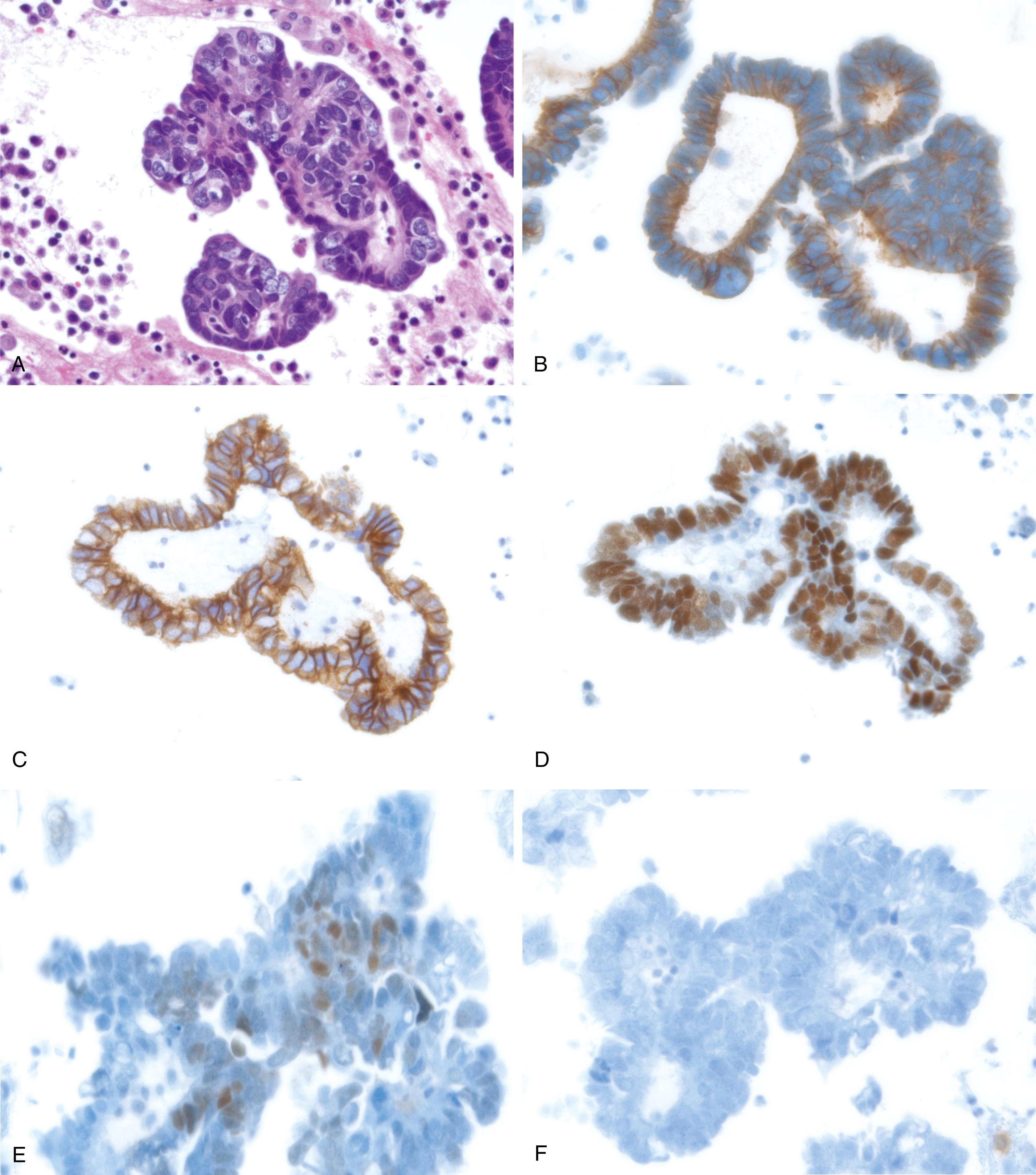
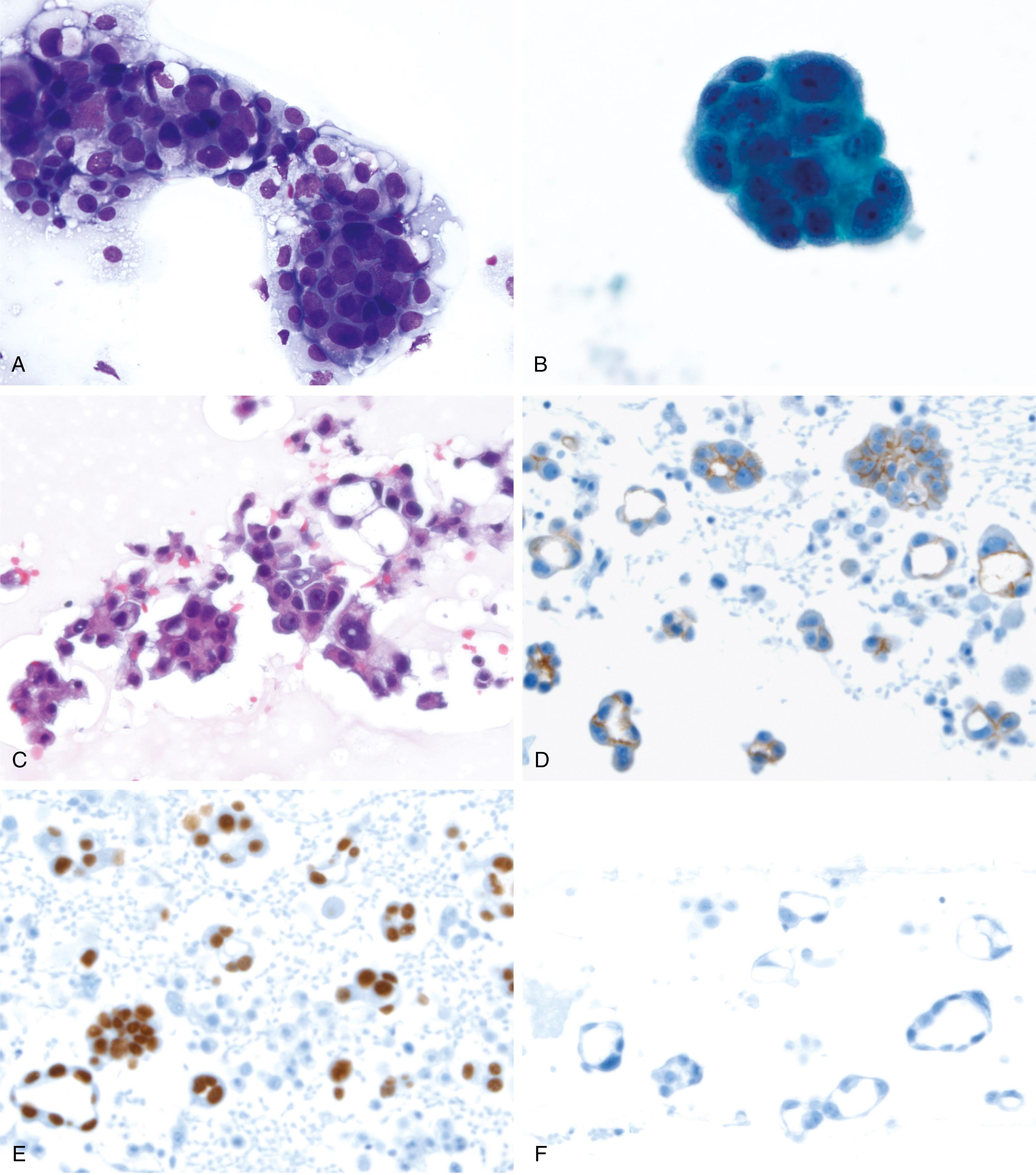
Become a Clinical Tree membership for Full access and enjoy Unlimited articles
If you are a member. Log in here